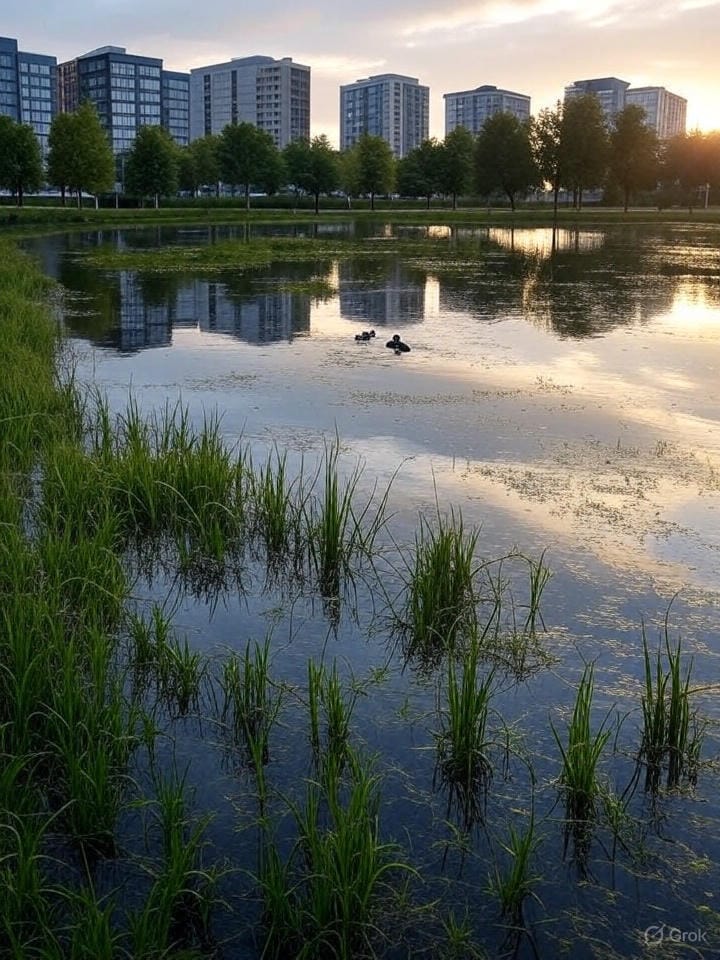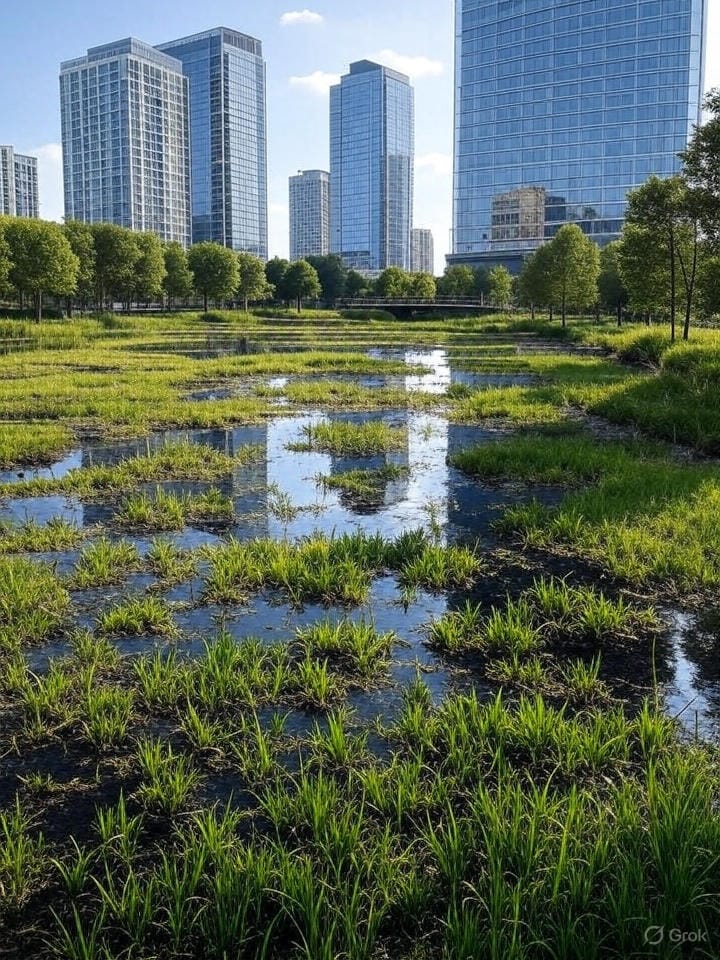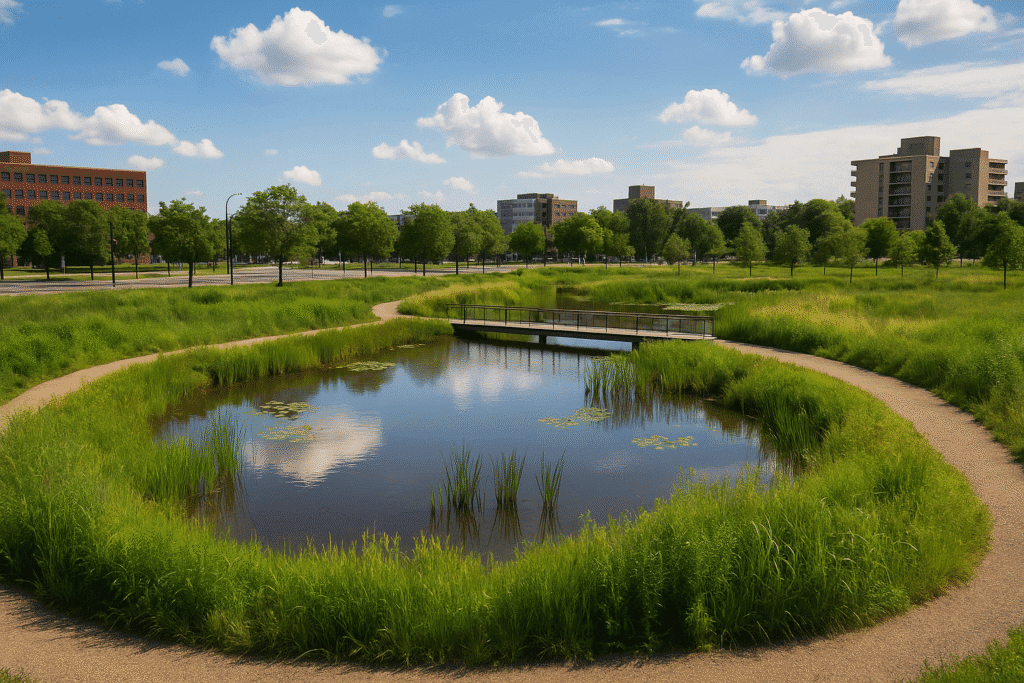
Table of Contents
ToggleWhat are urban constructed wetlands for stormwater management ?
When cities expand concrete replaces natural landscapes which creates several problems like flooding, water pollution and loss of urban biodiversity. So in response many urban planners and environmental engineers introduce a nature-based solution- urban constructed wetlands for stormwater management
A constructed wetland is a designed landscape where water flows through Vegetation, soil and sometimes gravel or pipes. It mimics natural wetlands to filter out pollutants from water. In urban areas they are used to manage water runoff, improving water quality and reducing heat. In this article we will cover benefits of artificial wetlands, challenges and limitations and future possibilities.
Top benefits of artificial Wetlands
According to the U.S. EPA, constructed stormwater wetlands achieve nitrogen and phosphorus removal rates typically greater than 50% which makes them a highly effective water quality tool.
Urban Constructed Wetlands offer aesthetic value with lots of benefits. These systems help cities to be more livable, resilient, and environmentally balanced. Here are some most impactful benefits :-
1. Constructed wetlands for stormwater management
Most primary benefit of constructed wetlands. They are highly effective in absorbing and slowing down excess rainwater. During heavy rainfall they help to reduce urban flooding. Their process is similar to BLUE ROOFS, they store water temporarily and slowly filter it out through Vegetation and soil.
2. Water purification
We know that constructed wetlands are made up of many different layers. So whenever storm water passes through Constructed Wetland then pollutants like oil, heavy metals and nutrients are filtered out by plant roots and microbial activity. This process significantly improves water quality before it enters other water bodies.
3. Urban cooling
These wetlands contribute to local cooling by increasing evaporation and replacing heat-trapping concrete surfaces. In heat-stressed cities they decrease the surrounding temperature and provide cooling. Their efficiency increased in cooling when they are combined with other green infrastructures like ROAD verges.
4. Urban Biodiversity habitat
Many small species struggle to survive in dense urban areas. These urban constructed wetlands provide a critical habitat for birds, amphibians and insects. Even a small wetland can attract many species.
5. Carbon Sequestration
Just like natural wetlands, artificial wetlands can store carbon in soil and vegetation. Yet this is not massive but still better than nothing, this carbon sink effect still supports broader climate goals, especially in a green infrastructure network.
6. Public health and green spaces
Human minds get relaxed when they feel greenery. Access to green areas like wetlands has been linked to lower stress levels and improved mental health. Many wetlands can also serve as parks or walking trails that give residents access to nature within the dense urban areas.
7. Cost-effective and long-term
Generally, many Green projects are dropped due to ongoing cost, but urban constructed wetlands’ maintenance cost is often lower than traditional concrete stormwater systems. The initial cost of artificial wetlands can be high, but it’s still better because over time they reduce the need for expensive infrastructure upgrades.

How do Constructed Wetlands actually work ?
Urban constructed wetlands might look like a small pond surrounded by plants at first sight, but in reality, it is a carefully engineered system designed to manage stormwater, clean pollutants, and support the urban ecosystem. Let’s study more deeply
Types of constructed wetlands :-
1. Surface flow Wetlands
In surface flow wetlands, Water flows slowly over a shallow plant-covered surface. These are visible pond-like systems used in parks or public spaces, which also support wildlife.
2. Subsurface flow Wetlands
In subsurface flow wetlands, water flows underground through gravel, sand,, or any other medium where plants and microbes treat it. These systems are more compact, low-odor, and favourable for tight urban areas.
Key components of urban constructed Wetlands
- Inlet zone from where stormwater enters
- Vegetated treatment area which is planted with native wetland species
- Filtration medium like soil, gravel or sand to filter out pollutants
- An outlet that controls how water exits, sometimes clean water is also used for irrigation.
How water moves and gets trapped in constructed wetlands for stormwater management
First, stormwater enters the wetland after rain, then it slowly flows down which allows sediments to settle. Then water is filtered through plants, roots, and microbes. Pollutants like oil nitrogen and heavy metals are broken down and then cleaned water exits at a controlled rate which helps to reduce flood risk.
| Natural Wetlands | Constructed Wetlands |
|---|---|
| Occur naturally in the environment | Man-made and engineered for a purpose |
| Irregular in form | Designed with specific flow control |
| May support a wider range of species | Often planted with select native plants |
| Slower to develop or recover | Can be built and functional within months |

Risk and cons of artificial wetlands in urban areas
According to the U.S. EPA, constructed wetlands require significantly more land area than conventional treatment systems and they are often ineffective in cold, hot-arid climates or areas with frequent flooding.
Constructed wetlands indeed offer impressive environmental benefits, but they are still not a perfect fit for every urban setting. In my opinion here are some limitations and risks that city planners must consider
1. Requires significant space
One of the biggest challenges is land availability. Artificial wetlands, especially surface flow systems, need wide open areas, and that is a scarce resource in dense urban zones. Retrofitting them into existing areas can be difficult or expensive.
2. Mosquito and Odor issues
If these wetlands are not maintained properly, then stagnant water zones can become breeding grounds for mosquitoes, especially in warmer regions. If there is a mosquito breeding hub, then there’s also a risk of unpleasant Odors because then organic matter will build up and decompose anaerobically.
3. Seasonal effectiveness
In colder climates, plant activity slows down during winter, which reduces the wetland’s ability to treat water and support biodiversity. Ice and snow formation can also affect water flow because they act as a barrier for water to flow.
4. Limited performance during extreme Rain Events
Wetlands can handle normal rain quite well but during intense storm rainfall they can be overwhelmed. These intense, short-duration storms are becoming more common with climate change, hence overflow systems may be needed to prevent flooding.
5. Complex Design and Maintenance
Designing a wetland that balances water quality, low-rate vegetation health, and space constraints requires expertise and highly skilled engineers. Ongoing maintenance is also essential because clogged inlets, dying plants or sediment buildup can quickly reduce performance.
6. Not universally Applicable
Some sites are not suitable such as highly contaminated industrial land, steep slopes or ultra-compact city centers. In such cases underground or mechanical stormwater systems may be more practical.
Despite these drawbacks many of the limitations can be reduced with proper site selection, favourable design and regular management. In most urban cases, the long-term benefits are better than the initial struggle.

Artificial urban wetlands examples across the world :-
Now to prove the impact of constructed wetlands in action I will give some worldwide examples where the systems are already making a difference. These examples highlight the flexibility of wetland design and their performance in every climate.
Tanned springs park – portland, Oregon USA
Once it was a polluted railyard, but when this wetland park was restored in downtown Portland, it began to act as a stormwater filtration system and wildlife refuge. It collects and treats urban runoff from surrounding streets. Its design combines native wetland vegetation with artistic boardwalks. Since restoration, it has improved water quality, supports bird species, and works as a public green space.
Bishan-Ang Mo Kio park, Singapore
This is an award-winning urban Park which integrates a meandering river with a series of constructed wetlands. It manages stormwater from nearby residential zones. Its design includes a naturalistic layout with planted wetland zones and floodplains. It has reduced flood risk, enhanced Biodiversity, and draws over 3 million visitors a year.
Sydney Olympic Park wetlands, New South Wales, Australia
This constructed Wetland for stormwater was built for the 2000 Olympics. It’s a large scale urban wetland system that treats stormwater before it reaches the Parramatta river. It filters runoff from 430 hectares of nearby urban land. Its design includes freshwater and saltwater wetlands with viewing platforms. It treats millions of liters of water daily and supports over 180 bird species.
Are constructed wetlands for stormwater a smart solution ?
We came across the benefits of artificial wetlands, urban wetlands examples,, and major limitations of urban constructed wetlands. But is it worth it? Constructed wetlands are not a solution for every problem, yet when they are applied correctly, they offer cities a rare opportunity that combines stormwater infrastructure with ecological restoration. These systems prove that green infrastructure can be both functional and beautiful by reducing flood risk and creating habitats in dense cities. So for cities willing to invest in proper planning and management, constructed wetlands are not just effective but they are also essential.
FAQs
What is the main purpose of urban constructed wetlands ?
The main purpose of a constructed wetland in urban areas is to manage and treat stormwater runoff. These systems mimic natural wetlands to filter pollutants, reduce flooding, and improve water quality using vegetation, soil, and microbial processes. In addition they support biodiversity and offer green spaces.
How effective are constructed wetlands for stormwater management ?
Constructed wetlands are highly effective for treating stormwater. They can remove up to 90% of sediments, nutrients and heavy metals from runoff depending on design and maintenance. Subsurface systems are particularly efficient in compact urban spaces that offer year-round performance with lower maintenance needs.
What are the disadvantages of using Constructed wetlands ?
The main disadvantages of constructed wetlands are the need for large land area, potential mosquito breeding, reduced performance in winter and the requirement of regular monitoring. In dense areas, space constraints and high installation costs may also limit feasibility.
